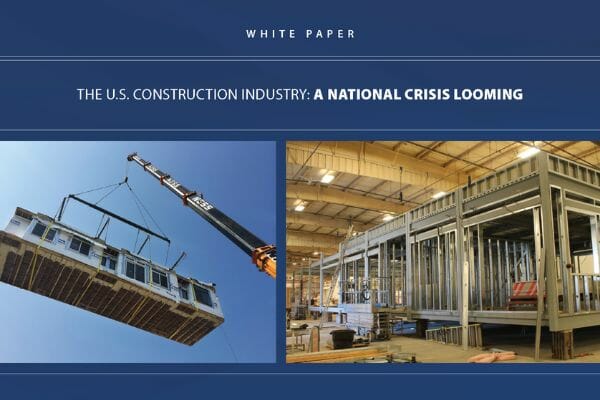The Modular Solution to the Construction Labor Shortage
It is not too difficult to find articles citing the construction industry’s woes over the shortage of available skilled workers. All sorts of initiatives, efforts, and conferences have been held on the topic for the last decade or so in an effort to reach more young people and gain more entrants into the industry.
According to the Bureau of Labor Statistics (BLS) and National Association of Home Builders (NAHB) there are currently 143,000 vacant construction positions nationwide. And these job openings are not minimum wage positions either. BLS data shows that the mean wages for a person in the non-residential building industry is just over $25 per hour. Of course, this is a general average among all trades and regions, but certainly respectable pay
A recent survey by the NAHB revealed that 69% of its members were experiencing delays in completing projects on time due to a shortage of qualified workers, while other jobs were lost altogether. And the problem isn’t going away anytime soon.
According to the 2015 Workforce Survey Results from Associated General Contractors (AGC) of America, over 60% believe it will continue to be hard to hire or become harder to hire construction professionals. In 2010, the average age of a construction worker was 40.2 years. By 2016, that number rose to 42.7 years, demonstrating that the workforce continues to age.
So, if we have nearly 150,000 openings at an average of $25/hour, why can’t we fill these jobs? In our opinion, it comes down to three things:
• Lack of workforce training
• Culture of inefficiency
• Working harder, not smarter
Lack of workforce training
Just because there are 143,000 openings now, doesn’t mean there are 143,000 qualified people to do the work where it needs to be done. Over the past decade, U.S. educational policies and resources have shifted more towards college readiness, at the expense (we think) of vocational training programs. Local, state, and federal policy makers need to recognize and support the value and importance of community colleges, apprenticeship programs, and vocational training on our economy. (See sidebar story on TRACOM).
The outlook for the construction industry, in terms of job opportunities, is strong. On their website, BLS states: employment of construction and extraction occupations is projected to grow 11% from 2016 to 2026, faster than the average for all occupations, a gain of about 758,400 new jobs. Overall growth in the economy and population will increase demand for new buildings, roads, and other structures, which will create new jobs in construction and extraction occupations. The median annual wage for all construction and extraction occupations was $43,610 in May 2016, which was higher than the median annual wage for all occupations, which was $37,040. If we can’t find workers now, where will we find the three quarters of a million more workers needed to fill these positions?
Culture of Inefficiency
In the construction industry, nearly 42% of all workers are employed by “very small employers” (defined by the U.S. Census Bureau as fewer than 20 people). That is nearly 2.5 times the national average of 17.6% of all workers in all industries employed by very small firms.
Many of these very small employers have little to no experience with the challenges of owning and operating a business. Specifically, smaller contractors struggle with recruiting, screening, and training new employees, navigating the human resource requirements, offering and managing fringe benefits, and regularly evaluating and promoting workers. “Training” consists almost exclusively of on-the-job experience.
So, it may not be a huge surprise to learn that safety has been, and continues to be, an issue in the construction industry. The BLS reports that there were 985 industry fatalities in 2015, up 5% from 2014. There was also a 15% increase in the number of reportable injuries and illnesses, according to that same 2015 AGC workforce survey.
These issues lead to higher costs, higher turnover, lower productivity, and lower employee morale. Within the private sector, workers in manufacturing had the highest tenure among major industries, at 5.3 years in January 2016, compared to 4.0 years for the construction industry (BLS).
Working harder, not smarter
The reality is actually the opposite of the old saying we’ve all heard 1,000 times. When it comes to construction, the answer always seems to be “we need more people.” The construction industry is one of the few remaining industries so heavily reliant on physical labor, embracing the “next man up” mentality. No time for training, gotta get the job done on time.
According to McKinsey Global Institute: “Consider that in the United States between 1947 and 2010, agriculture achieved cumulative real growth in its productivity of 1,510% and manufacturing 760%. Construction managed only 6%. U.S. construction-sector productivity is lower today than it was in 1968, and investment has fallen over the past decade. Over the past 20 years, productivity has grown at only 1% annually, only around one-third the rate of the world economy and only around one-quarter of the rate in manufacturing."
What’s the Message?
Is it any wonder that younger people are NOT entering the construction industry? Our policy makers place little to no value on vocational training. Small employers are more focused on selling the next job than training and retaining employees. Fringe benefits? Steady paycheck? Maybe, maybe not. Hard work, harsh outdoor environments, risky working conditions? Highly likely. Cool stuff like technology, automation, building information modeling? Not at most of the construction companies – no time, budget, or appetite for those things.
Related Reading:
The U.S. Construction Industry: A National Crisis Looming
With the U.S. economy strong again and unemployment rates historically low, one might wonder why anyone would think a crisis is looming. The answer is simple: there are not enough skilled workers to build all the projects that need to be built in the same manner they have been built in the past. The demand (need) for construction in the U.S. is high while the supply of labor is flat and declining relative to demand.
The Modular Solution to the Construction Labor Problem – Industrialization
Currently, the modular industry in the United States accounts for about 3% of all new building and home construction starts, a much lower adoption rate than in other developed nations. In Japan, for example, nearly 20% of all homes are constructed with an industrialized or prefabricated process. Sweden has the highest adoption rate with a whopping 84% of detached homes prefabricated.
There is a major difference between the US (and Canadian) industry compared to other European and Asian countries. In North America, we still CONSTRUCT buildings piece-by-piece, nail-by-nail, site-by-site, with all the variables, conditions, and challenges associated project-by-project. Other countries approach their construction industry with a manufacturing and assembly focus. They think in terms of processes instead of projects with a goal of minimizing waste and inefficienc
The Japanese are experts in lean manufacturing techniques. They used this expertise to “school” the U.S. auto industry in the 1970s-80s. They also transferred their knowledge and best practices from their auto industry to their construction industry. Today, about seven major modular home factories in Japan crank out over 100,000 homes annually. That’s more than the entire U.S. modular home industry. Ironically, the U.S. auto industry DID eventually learn this lesson and now assembles cars made up from components manufactured at other plants. It no longer takes a mechanic to build a car.
Another major difference in adoption rates is that other governments are banking on and supporting industrialization and manufacturing efforts. The U.K. government recently announced a deal with a Chinese company to open six manufacturing plants in the U.K., employing U.K. citizens and building 25,000 housing units for the people of the U.K.
Now, at this point you may be thinking that industrialization of the construction industry would mean FEWER workers needed. Possibly. More accurately it would mean workers with a slightly different skill set are needed.
Japanese modular home manufacturer Sekisui Heim, the house-building segment of the Sekisui Chemical Company, is one of the largest modular home manufacturers in the world. The company employs nearly 4,000 people at their eight manufacturing plants, which produce over 1,000 homes each month. Simple math shows that on average, 4 workers build one home each month.
Many countries are embracing industrialization in part due to difficulty in finding labor, but also due to the high demand for more affordable housing inventory. In the U.S., we currently have:
1. A shortage of skilled construction labor.
2. A shortage of decent, affordable housing inventory.
3. A vastly under-utilized manufacturing base/ infrastructure.
4. A need for more stable, predictable jobs.
The modular industry can offer more predictable work locations and hours, less labor-intensive work, a higher degree of technology integration in the work place, and much safer working conditions.
We can serve as a catalyst for the major rebirth of the US manufacturing base, creating thousands of new jobs while addressing our own massive infrastructure needs. It just makes sense, doesn’t it?
Now, here’s the kicker – if U.S. construction industry and policy makers DO NOT endorse/encourage/ support the industrialization of the construction industry, it will happen anyway with someone else in the driver’s seat. Foreign investment will continue to flow into U.S. construction markets. We can encourage investment in our manufacturing capabilities, or we can keep trying to sell buggy whips, rotary phones, polaroid film, and beta max movies.
Training Program Provides Skills and Credentials for Industry
TRAMCON (TRAining for Manufactured CONstruction) is a $10M grant-funded program through the U.S. Department of Labor. TRAMCON is a consortium of 4 Florida colleges (Miami Dade College, Santa Fe College, Polk State College, and Seminole State College) selected to provide a tuition-free training program in manufactured construction.
The program combines curriculum developed by the University of Florida, National Center for Construction Education and Research (NCCER), and the Manufacturing Skill Standards Council (MSSC) to create a standardized model for manufactured construction. TRAMCON is designed for participants to gain stackable qualifications which consist of up to seven credentials and certifications (OSHA, MSSC, 3 NCCER Credentials, Fork Lift, and Aerial Platform certifications).
The purpose for the development of the TRAMCON program is to provide training for the manufactured construction industry in order to increase productivity and reduce turnover of employees through training and education. To date, the consortium has 1,744 participants, 1,356 completers, and 1,687 certificates earned.
Santa Fe College has had amazing success stories with these participants. One participant who had been unemployed for quite some time completed the foundation level of training and was placed in a job in a local woodworking shop. He continued the TRAMCON program and completed Basic and Advanced Levels while working fulltime. Another participant came in as an unemployed veteran. He had previous construction experience, but had no credentials or certification to show for it. He completed the foundation level of training and gained employment with a local company that manufactures and builds theme park attractions and decorations. He has since been promoted from his original position and loves his job!
The program is currently in the wind-down stages of training and will end on March 31, 2018. The participating schools are now looking for ways to assist employers and industry leaders in educating and training employees in manufactured construction. Over the past two and half years using the TRAMCON model, the program administrators have a good idea of best practices, what works, and how to best deliver manufactured construction training. The goal is to see TRAMCON continue as either a short training program, a pre-apprenticeship model, or a full apprenticeship model.
If you are interested in learning more about this program, contact MBI for program details.
This article originally appeared in the Modular Advantage Magazine - First Quarter 2018 released in February 2018.
More from Modular Advantage
Samantha Taylor: Leading the (Modular) Design of Tomorrow
“With modern technology and the way we’ve all embraced things like BIM, file sharing, and video conferencing since COVID, it’s easy to collaborate with companies in Austria, or Singapore, or anywhere else in the world.”
Greg DeLeon: Military Engineering to Modular Design
Greg DeLeon, a structural engineer at ISE Structural Engineers in Temecula, California, can tell you not only how large a beam needs to be to support a house, but also how much explosives you’ll need to take it down, thanks to his unique combination of professional and military experience.
To Remake North Minneapolis, Devean George Swaps Basketball for Buildings
He’s lived in Los Angeles, Dallas, and San Francisco (to name a few). He’s delivered championships with the Los Angeles Lakers and made career-defining moves with the Dallas Mavericks and the Golden State Warriors. No matter the wins, the championships, or even the seemingly impossible 3-pointers, Devean George has always returned to where it all started for him: Minneapolis.
Chelsi Tryon: Making the World a Better Place
For Chelsi Tryon, Director of Environmental, Social, and Governance (ESG) for WillScot Mobile Mini, nothing is more enjoyable than increasing the
company’s sustainability efforts while simultaneously doing her bit to save the environment.
Joshua Hart: Pushing Boundaries
Joshua Hart, P.E., vice president at Modular
Solutions, can sum up his job responsibilities in one sentence: “I do whatever needs to be done.” Hart thrives on the variety and the opportunity to be involved in every aspect of the company. And it shows! You might say Hart has come full circle.
Jamie Metzger: From Construction to Apparel and Back Again
Growing up in a blue-collar city like Edmonton, Alberta, Canada, it’s no surprise that Jamie Metzger spent some time working labor jobs on construction sites. It’s one of the most common summer jobs in the city. But that’s probably the last predictable thing about this particular story.
Victor Masso: Expanding Modular in Puerto Rico
Victor Masso joined 2 Go Storage, a company started by his grandfather and father, in 2018 to develop a modular building division in the wake of the devastation caused by Hurricane Maria in 2017. Prior to joining the company, he had worked in the industry for about four years focusing on pharmaceutical, commercial, and government projects.
Eliyah Ryals: Finding the Perfect Fit
It’s not common for people to find their perfect career fit straight out of college. It’s even less common to find it in the town you grew up in. But that’s exactly what happened when Eliyah Ryals was told about vacancies at Panel Built and made the decision to apply.
Through It All, It’s Still About the Workers
By February 2024, the number of available, unfilled construction job openings had reached an all-time high. At some point, interest rates will fall, creating another surge in demand for such workers. In short, solving the nation’s skilled worker shortage issue has never been more important.
Navigating Insurance Challenges in the Modular Construction Industry
Utilizing practical written minimum insurance and indemnity requirements, along with monitoring certificates of insurance by someone who has COI training will not yield a perfect risk transfer strategy, but the exposure will be managed much better than it likely is currently.











